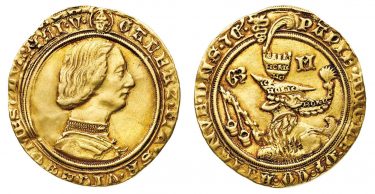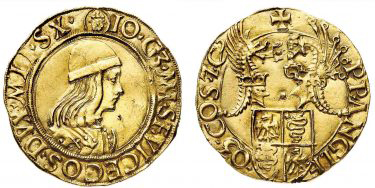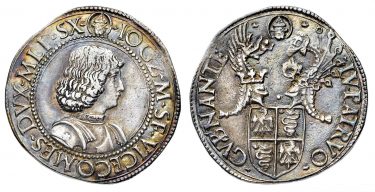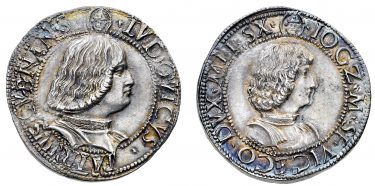ART AND POWER IN RENAISSANCE PORTRAITS ON THE MILAN COINS

The Renaissance has its roots in the rebellion of the Municipalities towards Imperial power, in the profound renewal of spiritual life and more generally in the mood of the men of the time, who were beginning to look passionately for beauty in the world, finding it in ancient classical culture and in a revival of the arts.
This thirst for beauty determines the almost contemporary birth of artistic expressions which had never been seen before, except perhaps in Pericles' Athens, and were never to be seen again. There is no Italian city that is not adorned with the fruits of this great art and, to quote Bernareggi, the illustrious numismatist, to "this same great art we must refer the coins that we are considering", a series of coins of extraordinary beauty which carry the portrait of princes, sovereigns and pontiffs, from a period going from the middle of the XV century to the first decade of the next century. An attention to beauty which, in coins, is combined with a new style of political propaganda.
The best expressions of this combination are found in the Duchy of Milan after 1450, an era characterized by the domain of the Sforza family, who left us numerous numismatic testimonies, some of which will be present in the upcoming
Aste Bolaffi sale on the 28th and 29th of November.
The first of these testimonies, which we examine in order to comprehend the importance of aesthetics in the political message, is the double ducat of Galeazzo Maria Sforza.
Milanese coins also had an enormous international relevance, and it is quite obvious that a gradual change was taking place towards new forms of political propaganda. Sovereigns on horseback were a strong sign in the fifteenth-century monetary landscape. While Francesco Sforza preserves this type of representation, the new Sforza dukedom, however, is distinguished by the head of the sovereign. And the head, with Galeazzo, becomes the coin's undisputed protagonist.
Wealth and power must emerge from the portrait, the face of the Lord shows itself in new and personal forms, while the diameter of the coins becomes progressively wider and increasingly available to represent as closely as possible the authority of the Duke.
A further evolution of style takes place a few years later with Gian Galeazzo Maria. The decisiveness of the portrait of his predecessor gives way to the fine and delicate features of the young Duke and the admirable plastic synthesis centered on the hair, on the typical cap and on the profile present in the double ducat, characteristics that make it one of the most admired examples of the Renaissance series.
This rapid excursus into the Renaissance currency of Milan continues with two silver coins that well represent the power games of the period. Ludovico il Moro has been back in the city for some years and with wit and various deceptions, he succeeds in taking over from Bona di Savoia the role of Gian Galeazzo's regent, becoming the true master of Milan.
While the first of the two silver testoni shows the Duke alone combined with the symbols of the city government, the second shows how the rise to power of Ludovico il Moro is now complete, with his portrait coupled with that of his Lord in a specimen that is perhaps to be considered as the most artistically prestigious of those issued by the Milan Mint.
It should also be noted that the two portraits have slightly different proportions, with the profile of Ludovico being slightly larger, as to emphasize the dominance over his nephew.
In conclusion, we can therefore affirm that once again numismatics and politics prove to be deeply linked, but we also see that, during the Renaissance, the artistic element returns to enrich and reinforce this union, becoming a constant to the present day.
BROWSE THE AUCTION CATALOGUE



